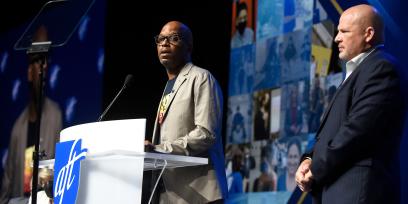In a Special Order of Business, Convention 2022 delegates unanimously adopted a new report and recommendations from the AFT Teacher and School Staff Shortage Task Force . The report, titled Here Today, Gone Tomorrow? What America Must Do to Attract and Retain the Educators and School Staff Our Students Need, embodies seven months of intensive work by the task force, which is made up of 25 leaders from AFT state and local affiliates across the country.
The group worked with research and policy experts in the field, sought input from AFT state and local leaders, deployed in-depth member surveys and held numerous listening sessions with members who shared their frontline experiences.
The result is a landmark analysis that examines the root causes of snowballing shortages and spells out practical strategies for attracting and retaining the educators and school staff our students need and deserve.
"Despite the pure heroism our teachers and schools have shown during the pandemic, too many communities are not investing in public education,” said Michael Mulgrew, task force co-chair, president of the United Federation of Teachers and an AFT vice president.
Task force Co-Chair Carl Williams, president of the CFT Council of Classified Employees and an AFT vice president, praised union leadership for ensuring the inclusion of paraprofessional and school staff in this vital work, especially given their vital role in the services that keep schools running, from student transportation to food service.
Williams said, “The workers, the people on the ground, see the problems shortages cause up close, which is why we heard directly from them to find solutions for this report."
AFT President Randi Weingarten called it “probably the most important task force in our history.”
Longstanding issues, recent crises fuel snowballing shortages
The report details statistic after statistic reflecting America’s current, unprecedented shortage of teachers and school staff. As Mulgrew told delegates, “It is scary stuff.”
An AFT member survey last month by Hart Research Associates showed the lowest job satisfaction ratings for PRSPs ever recorded and revealed that 79 percent of teachers said they’re dissatisfied with their current overall working conditions. It also revealed that three-quarters of teachers say they would not recommend their profession to others. In another troubling sign, a RAND Corporation survey last month said about one-third of teachers and principals reported that they were likely to leave their current job by the end of the 2021–22 school year.
There’s also a diversity crisis: Almost 79 percent of U.S. public school teachers are white, while 7 percent are Black and 9 percent are Hispanic. Yet less than half of students are white. Schools serving majorities of students of color and students living in poverty experience the highest teacher turnover rates.
As Weingarten emphasized, the roots of the shortage crisis go deep.
“Teachers and school staff have been struggling for years with a lack of professional respect; inadequate support and resources; subpar compensation; untenable student loan debt; endless paperwork; and a culture of blame that weaponizes standardized tests to attack public schools and public school teachers,” said Weingarten. “And then came COVID. The pandemic, combined with the political culture wars, made the last two years the toughest in modern times for educators. On top of all of that, the unthinkable happened again, when gun violence took the lives of 19 students and two teachers in Uvalde, Texas.”
Weingarten said, “We have a shortage of respect for educators. A shortage of the professional working conditions that allow teachers and other staff to do their best for their students. We have a shortage of pay for what is arguably the most important job in the world. No wonder teachers’ job dissatisfaction is up 34 points since the start of the pandemic.”
Focusing on solutions
Here Today, Gone Tomorrow? offers practical, research- and experience-based strategies to reverse the shortages and revitalize the education profession, including:
- increasing salaries and benefits;
- shrinking the “teacher pay penalty,” or 20 percent disparity between teacher pay and that of college-educated non-teaching peers;
- diversifying the educator workforce, through promising practices such as Grow Your Own programs and sustained mentoring;
- lowering class sizes;
- curbing the nation’s “test-and-punish” obsession with standardized tests;
- reducing the endless paperwork collected for administrative purposes and districtwide reports; and
- expanding the scope and reach of collective bargaining, which is the best way for teachers and school staff to have a voice to advocate for what their students need.
The report emphasizes treating teachers and school staff like the professionals they are, with time to plan and prepare for classes, the chance to collaborate with colleagues, the power to make day-to-day school decisions and ongoing professional development.
It also calls for turning schools into community hubs that serve the needs of the whole child and the whole family. This means investing in thousands of community schools with wraparound services—a model that is working across the country, including in the 700 community schools (to date, and counting) that the AFT and its affiliates have helped create.
Putting it into practice
Mulgrew and Williams urged delegates to see the report’s adoption as a true call to action.
“We know how to reverse this trend. Our responsibility is to make it happen. Our students are depending on us," said Mulgrew.
“Please don’t forget about us,” said Williams, speaking of the vital role PRSPs should play in solving the shortage crisis. “The answer to staff shortages isn’t ‘one size fits all,’ but this report will help guide us in the right direction so school support staff—custodians, bus drivers and other paraprofessionals—can advocate for the working conditions they deserve.”
Weingarten sounded a hopeful note. “I’m confident that our country can learn to treat and respect teachers and school staff in ways that befit their importance to our society. In the process, we will not only save our profession and revitalize our schools but also build a better future for all.”
[Christina Bartolomeo/photo by Michael Campbell]

